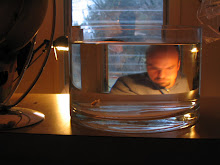 All right, halfsteppers: let's put on those visual studies hats, and take a quick look at Constantin Alajalov's 1959 Moonlit Future (above). A handsome young couple reclines against a sturdy tree, and peers up at the summer night sky, where a cloud of imagined futures appears, gossamer-like, against the tapestry of stars. A vacuum cleaner, a television, a pool, a station wagon: the two see, among other things, a life of modern convenience and creature comforts ahead of them. in addition, a lovely house awaits them, and a boy shags a fly ball and a girl sits upright at a piano. The full moon presides, then, over a destiny that seems spun out of simple conformity with mid-century goals: these two wish for a nuclear family, a modern household, and - well, the rest is merely implied, rather than written in the stars.
All right, halfsteppers: let's put on those visual studies hats, and take a quick look at Constantin Alajalov's 1959 Moonlit Future (above). A handsome young couple reclines against a sturdy tree, and peers up at the summer night sky, where a cloud of imagined futures appears, gossamer-like, against the tapestry of stars. A vacuum cleaner, a television, a pool, a station wagon: the two see, among other things, a life of modern convenience and creature comforts ahead of them. in addition, a lovely house awaits them, and a boy shags a fly ball and a girl sits upright at a piano. The full moon presides, then, over a destiny that seems spun out of simple conformity with mid-century goals: these two wish for a nuclear family, a modern household, and - well, the rest is merely implied, rather than written in the stars.As you might have guessed, though, what really catches my eye here is the characterization of son and daughter. The son runs, presumably outside; the daughter is static, and indoors. The boy aspires to be athletic; the girl, perhaps, artistic. He's loosely diagonal; she's primly vertical.
Now, admittedly, it may be unfair to put much pressure on such minor details. And, of course, there certainly were little boys catching balls, and little girls playing scales, throughout 1950s America. But wait a minute: ultimately, these aren't exactly minor details. Rather, they're the rough embodiment of family planning, on the cover of a widely circulated magazine. In other words, they're not merely offhanded characterizations; rather, they're part of a larger process of definition, or socialization. Boys play sports, and girls play pianos. And boys who play pianos? Well, during the McCarthy years they were often seen as slightly less than boyish; indeed, as the composer Ned Rorem later remembered, his interest in learning to play Ravel as a boy served as an early perceived indicator of his homosexuality. In fact, even Charles Schulz' Schroeder, who began to play Beethoven on his toy piano in 1951, was recently depicted, in a contemporary play, as a middle-aged gay man. The point? Images like Alajalov's both draw on and perpetuate social assumptions. To use academic lingo, they're models of, and models for, behavior.
Again, there's nothing necessarily wrong with that; all images do something of the sort. But, still, one wishes that works like Alajalov's could somehow accommodate a more flexible, or less simply predictable, world view. Given images like this, the future of a little girl like Cleo feels restrictive and even foreclosed: she's virtually expected to take piano lessons. But what if her talents lie elsewhere? What if she enjoys, say, wrestling? Or what if she prefers blue to pink? Or DiMaggio to Scarlatti?
The boy plays ball. The girl plays piano. And the pool, sadly, remains empty. As a result, I want to nudge Alajalov's girl towards the water. Go on, put on a suit - and don't just recline, like your handsome blonde mother. Jump in! Splash about! Invent a game or two, and swim strongly, so strongly.
After all, Charles Shultz didn't only give us Schroder, the boy pianist. He also gave us the intense and unrepentantly infatuated Lucy. And Lucy, as you know, suited up for a number of ballgames in her day.




No comments:
Post a Comment